It is totally inexcusable that it took us over a year and half after moving to this country to make it to Košice, Bratislava's second biggest city, located at the eastern end of the country, but we finally managed it. Even though I've long been curious about the place, we usually opted for Prague or Budapest (or Krakow) whenever we've had the time and means to get away for several days. But we thought it was time to actually explore more of the country we're living in.
Even though Košice is Slovakia's second largest city, it's pretty small by the standard of most countries, with a population of only 240,000, which is a bit more than half of Bratislava's population of roughly 450,000. But it's a big university town, not to mention home to a massive U.S. Steel factory (which employs thousands) and a burgeoning IT industry, so even though it tends to be overshadowed by Bratislava, it's certainly not some isolated Deliverance-style backwater.
The train ride, which took five hours via an express line with only six stops, was worth it for the natural scenery. It runs through the northern part of the country, with the lush, densely forested hills of the Low Tatras to the south, and between
Liptovský Mikuláš and Poprad, the gloriously melodramatic, snow-capped peaks of the High Tatras to the north. Of course, you also see examples of pretty heavy industry along the way, as well as some hard-scrabble towns, which makes for a jarring contrast from all the vast stretches lush nature. Once you emerge from the forest into the outskirts of Košice, the first thing you notice, of course, are endless rows of panelaks that line the tops of the surrounding hills like jagged teeth.
The historical center
We spent a lot of our time exploring Košice's historical centrum, or center, and its immediate surroundings. The old town is centered around a long, slender sort of oval-shaped (lenticular) public square/main drag, known as
Hlavná ulica, and what struck us about it was not just the endless cavalcade of attractive ornate, historical facades, but that the place was bursting with life - and not from hordes of ambling tourists, but from locals! In fact, I could count the number of tour groups we saw on one hand, and I felt like I was the only idiot with a camera snapping photos of stuff. Everywhere we went, the predominate language was Slovak. I heard almost no English, and maybe a smattering of other languages. There were no tacky tourist trinket shops or carts cluttering up the place, either.
Hlavná had a real pulse, and an alluring vibe, and I was pleasantly surprised to see that, unlike in Bratislava, locals were flocking to the main square in droves and really taking advantage of it.
The locals definitely appear to make very good use of their public space, and so they should - it apparently cost a fortune to reconstruct during the 90s. But the center of
Hlavná, between the city's gorgeous gothic St. Elizabeth cathedral and the grand neoclassical/art nouveau mash-up that is the State Theater, is an extremely inviting public space, designed by people who apparently understood how to make people
want to use it. Under a shady canopy of tall trees, the walkways are lined by an ample number of benches, which are actually
not uncomfortable, and which, at certain times of the day you might have to fight for.
You've got all generations represented here, from teenagers making out, to pensive university students reading thick tomes with cigarettes dangling from their lips, to couples with little kids spazzing out around the fountain, to old pensioners leaning forward on their canes. It's a nice place for people watching, which is a true sign of a well-conceived public space as well as a city with a somewhat diverse demographic.
The central feature of this part of the square is the large "singing fountain," an admittedly silly concept where hundreds of thin streams of water shoot up in a kind of rhythmic undulation, roughly keeping time with the bland, inoffensive elevator music versions of top 40 radio hits that are lightly piped in through speakers hidden around the edges of the park. I know, it sounds unforgivably cheesy, but if you're sitting closer to the fountain, the sound of the splashing water drowns out the Phil Collins and Bee Gees tunes.
There are enough cafes and pubs up and down the kilometer-long
Hlavná with inviting outdoor seating to make an indecisive person's head explode, all of which offer front row seats to the street's bustling yet simultaneously cool European ambience, as well as more great people-watching opportunities. And once again, it's overwhelmingly locals who seem to be taking advantage of this.
Furthermore, Košice's historical center feels way more lived-in than Bratislava's. By that I mean, rather than feeling like an open-air historical museum/tourist trap/high end shopping center where few locals actually live (i.e. Bratislava), you get the sense that there is a community here, that people actually
live here (or not far away), and you can see them going about their business, or just hanging out and socializing at the myriad cafes or pubs and thoroughly enjoying the setting. In Bratislava's old town, you don't see this so much, as few locals live there and many seem to have a cynical disregard for the place, and seldom set foot in it. Whereas Bratislava's historical center feels more like a tourist zone during the afternoon and a ghost town at night, Košice's center is really quite lively and energetic throughout the day, and I can't emphasize enough what a huge difference that makes.
The cool St. Elizabeth gothic cathedral and other architectural highlights
Košice is also home to the stunningly ornate gothic St. Elizabeth cathedral, the city's architectural gem, which is quite possibly the most beautiful historical building in all of Slovakia (the travel guides will back me up on this). It's one of the only true gothic cathedrals in the entire country, and it's also the easternmost gothic cathedral on the European continent. Construction began in 1380 and continued into the 1500s. Unfortunately, nearly half of the facade is currently covered in scaffolding, which is a major bummer. I know, it's a necessary evil, but I admit that part of the reason I held off on coming to Košice for so long was that I was holding out for the cladding to come down. But having now seen it in person, it's clear that the heavy duty scaffolding isn't coming down anytime soon.
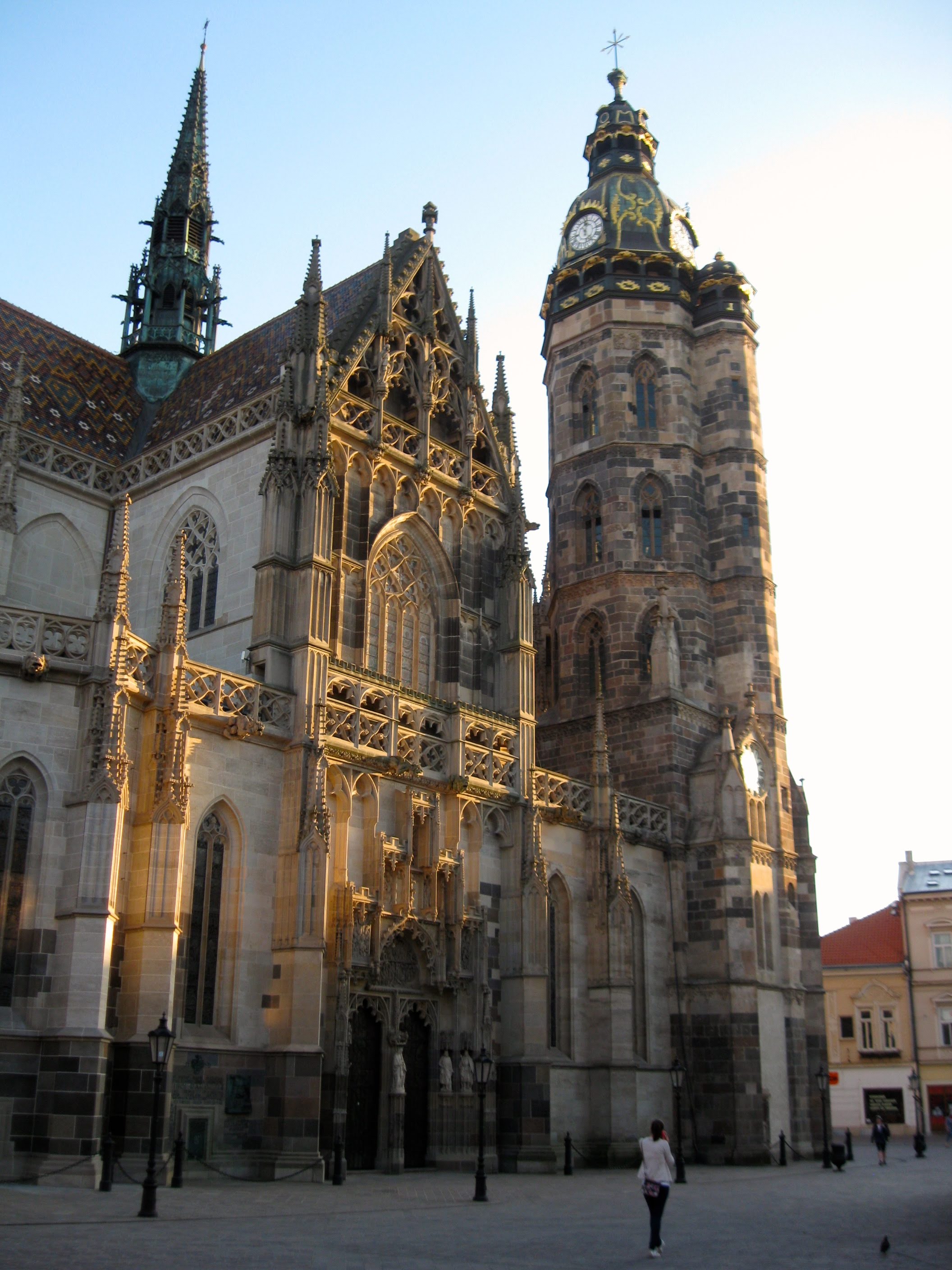
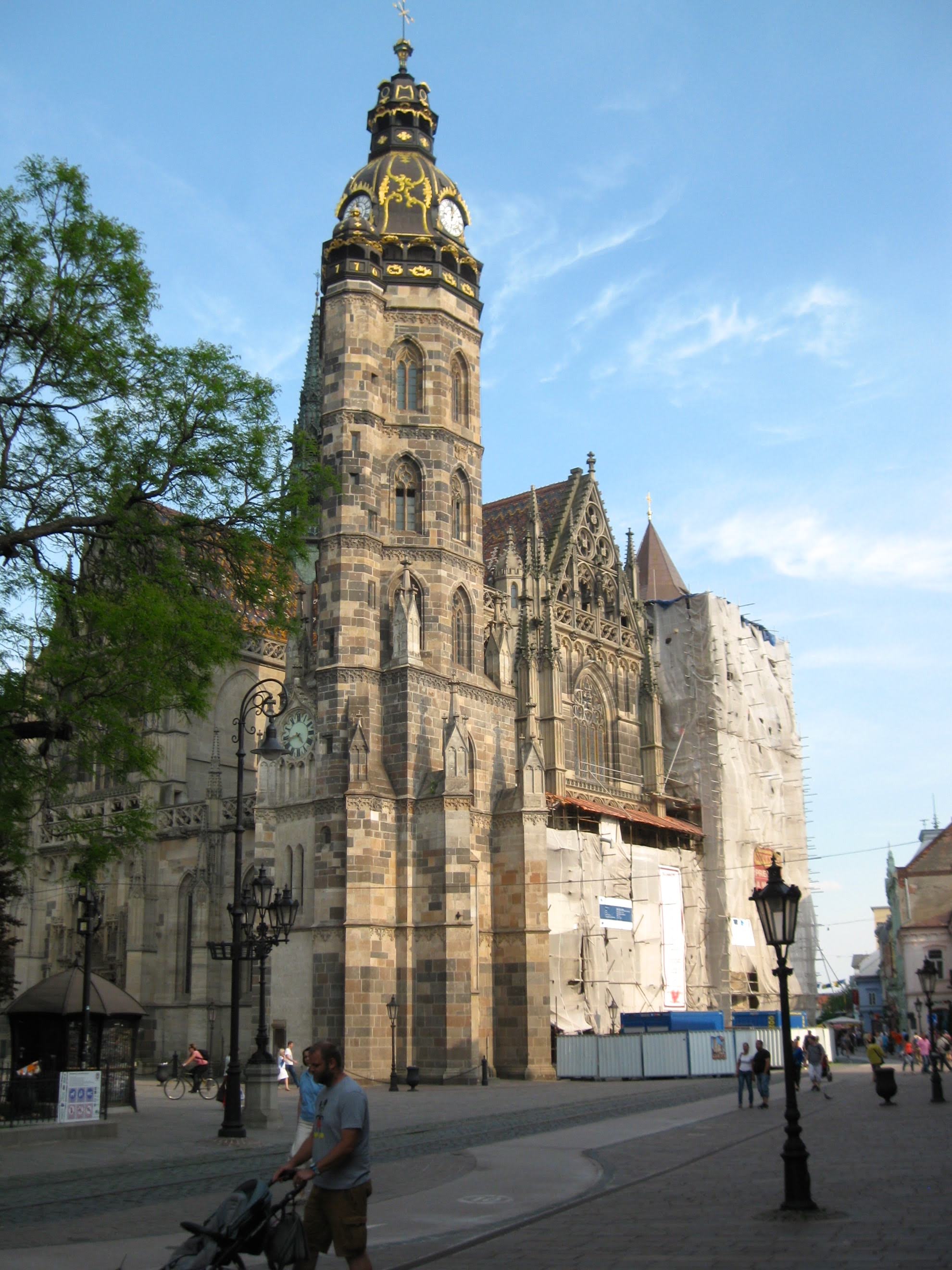
It's not a massive cathedral, but it's incredibly striking visually, and the fact that there's really nothing else like it in Slovakia, a country where most churches or cathedrals are generally rather bland, makes it extremely unique. It's the only cathedral or church in Slovakia that could rival anything in Prague. (Again, that Bratislava has nothing on par with this is a pity - even if St. Martin's wasn't compromised by the freeway in front of it, it still couldn't hold a candle to St. Elizabeth's). Parts of the interior have been scrubbed (and painted) to the point of looking brand new, which really detracts from a visual standpoint (I prefer the look of ancient marble and stone worn down by centuries of use), but it's still worth a peak inside.

But what pissed us off about this place, however, is its uncompromising hours. Near the top of my mental list of things to do in Košice was to ascend the cathedral's clock tower so we could take in the 360-degree views of the city and the surrounding area. First of all - I know, we really should've paid attention to the tower's opening hours the minute we got there, but we just figured we could leave the tower for Saturday afternoon. But we were so, so very wrong about that. You see, independently run shops in this country have outrageously uncompromising hours. Many places are open from nine to five during the week -
when most people are at work - but on the weekends, they're only open from nine to noon or one - a mere 3-4 hours - and then closed all day Sunday. So, this gives people who work 40 hours a week this tiny window on the weekends in which they can shop in anything other than big mega-chain retailers. (And they wonder why some independently run shops are hurting).
Stupidly, the cathedral,
one of the city's chief tourist attractions, has the same opening hours for its tower, and when we were there, closed on Saturday at one in the afternoon, which to me is kind of a middle finger to tourists. Now, I realize this isn't the Duomo in Florence, but geez, would it kill them to keep the tower open a little longer on Saturday, the day on which, statistically,
you're likely to have a higher number of visitors? The locals are accustomed to these idiotic hours, and think nothing of them (it's a communist-era holdover - Saturday's are "sacred" for workers, but apparently these people have never heard of staggered shifts), but why subject unsuspecting tourists to such uncompromising hours with the
things that they will want to see? This is yet another example of a country that is starved for more tourism, yet which is unwilling to go the extra mile to actually make the place more attractive or accommodating for tourists. So, yes, it was kind of a bummer not to be able to ascend the tower. End rant!
At any rate, Košice's old town is more than just
Hlavná. It's flanked by several narrow, intimate lanes, some of which are pedestrianized, and all of which possess a cool, low key charm, and are ideal for directionless wandering.
The architecture in general is quite striking. There's probably the same level of variety as Bratislava in terms of the historical periods that are represented - medieval, renaissance, baroque, 19th-century historicism, art nouveau, a bit of 1920s/30s functionalism, etc. But Košice seems to have a few things here or there that are a bit more strange or exotic than anything in Bratislava. Also, Košice's old town suffers far less from communist-era intrusion, which mostly seems to have been kept to the outskirts, although the commie stuff that we saw was noticeably less visually interesting than any of Bratislava's similar sites.
There's also an old synagogue on picturesque side street Zvonárska. I've seen
photos of the interior, which look amazing, but the synagogue, which is currently being used as a gallery, was closed when we were there. A banner out front had info on an exhibition from early last fall.
The food
Just about everything you read on Košice, including every issue of Spectacular Slovakia that I've seen, mentions a pub called Golem, which brews its own beer, and apparently makes a mind-blowing pork knee. But when we got there, the waiter told us that not only does the pork knee take an hour to prepare, but it's only served for parties of four. Adding insult to injury, if you want duck, you have to order it
a day in advance! Being a professional chef, Terezia confirms this is a sign of a lazy (and/or cheap) chef. All the other dishes involved either something fried or chicken breast, and I'm not always in the mood for fried food and chicken breast. So, we ordered some decent starters and a couple pints of their dark beer, which despite having a vaguely interesting coffee-flavored undertone, was basically flat and kind of one-note. I don't know why every issue of Spectacular Slovakia mentions Golem, but based on this experience, if I had been commissioned to do a Košice article for them, I'm not sure I'd mention this place. Still, it was nice to sit outside in the hot spring evening and soak up the ambience of Dominikanska square.
We did manage to have some quite nice
Šariš tmavý (dark), a beer with a more complex and rich flavor, at a pub right on
Hlavná near the cathedral. We also had some tasty Czech beer at a lively pub on a back street near the medieval
Mikluš prison.
On Saturday night we decided to forego Slovak food and went to A Passage to India. Neither of us have had Indian food since moving to Slovakia, but we are both wildly obsessed with it, given that Berkeley and San Francisco are overflowing with totally amazing Indian joints. My expectations were low for this place, however. After some not bad yet not amazing samosas, I ordered the chicken korma, and Terezia ordered something called butter chicken, which was tender chicken in a thick reddish curry. The korma had to have been the blandest example of said dish that's ever crossed my palette. The butter chicken, surprisingly, had a much richer and more complex flavor profile, and while still not mind-blowing (nor spicy), it was enjoyable. The naan, of course, was fine, but that's a difficult thing to screw up.
The city's socio-cultural-ethnic make-up
Something else Košice appears to have over Bratislava is a little more diversity among the local population. We saw a comparatively decent number of subcultures, e.g. punk rock kids, hippies, metal heads, and general weirdos - the kinds of people you could go for weeks without ever really seeing in Bratislava, but which more culturally switched-on urban areas tend to have in greater abundance. I'd heard that Košice had a bit more of a youthful energy to it, and I could definitely sense that. Both Bratislava and Košice are big university towns, but Košice actually feels like one. Bratislava, by contrast, is the only college town I've been to that doesn't really have a college town kind of vibe.
There is a second-hand record store located downtown, and record stores can be a great way to get a sense of the cultural with-it-ness of a city's population. The small shop was packed with LPs, but mostly 60s and 70s pop/rock that you can find anywhere. More impressive were the towering piles of vintage radios and stereo equipment that appeared ready to topple at the lightest touch.
Like Bratislava, however, Košice seems to be lacking in terms of ethnic diversity, although we did hear a few people speaking arabic, and there were a few non-tourist, non-caucasian minorities as well (like the owner and kitchen staff at A Passage to India). But, while Košice does suffer a bit from the sort of overwhelming whiteness that plagues Bratislava, there is one massively important difference...
Roma
Slovakia has a rather large Roma population, most of which resides in the eastern half of the country. I could probably count the number of Roma I've seen in Bratislava on one hand, but there are thousands of Roma communities throughout the eastern regions. Some say this is by design, that the state wants to hide them, or keep them "out of sight." Roma, of course, have a long history of being marginalized here, as in much of Europe, and many today live in extreme poverty amid squalid conditions, in areas that are segregated from the white population. The issue of Roma in Slovakia is extremely contentious, complicated, and delicate, and unfortunately there is considerable tension between the white people and the Roma minority, so the issue of Roma in Slovakia is best left for its own post, where I can give it the proper space. But racism, segregation, and classicism, are quite prevalent in Slovakia, in ways that bear an alarming resemblance to pre-Civil Rights America, and in some respect, to what goes on in impoverished American inner cities today.
At any rate, we saw numerous Roma in Košice. There was a particular group of them, at times numbering about 10 or so, who seemed to fit the classic Slovak stereotype of Roma. They basically appeared to be homeless, with dirty, worn out clothing and unwashed hair, and they could be seen rooting for food in garbage cans and sometimes begging for change. They reminded me a lot of the numerous homeless people you see in downtown Berkeley or in parts of San Francisco, so it's a sight that I'm quite accustomed to. A few of them, who appeared to be in their late teens, looked - literally - cracked out, and would sort of pace around the town like zombies. Others were clearly not on drugs, but were actively scavenging for food from wherever they could find it.
One guy, who appeared to be two sheets to the wind, staggered up to us when we were eating at Golem (at our table out in front) and asked if we were going to finish the food on our plates. But before either of us had a chance to do or say anything, a man at the table next to ours stood up and shouted quite aggressively at the guy, telling him to scram, and the Roma man stumbled off. In the same square, we also saw an adolescent Roma girl and her younger brother, who were also scavenging and occasionally begging for change. At one point a group of similarly-aged white girls walked by, whose squeaky clean appearance stood in stark contrast to the Roma girl in her worn and dirty clothes. I noticed her looking at the girls, and one of them shot a quick glare of utter contempt back at her. The Roma girl seemed unfazed by this and just kept watching them passively as they walked by.
But we also saw as many, if not more, Roma who more or less blended in with the local population. We noticed a few teenage Roma couples making out in the main square who had the same clothes as their white counterparts, as well as several Roma families who were just out with their kids, enjoying the setting, and quite noticeably not begging or scavenging. We also saw some people who were somewhere in between, i.e. they were clearly making an effort to at least look like they were not homeless or living in abject poverty, yet they were still asking for spare change. What's interesting about all this is that I've met Slovak after Slovak who can't utter the word gypsy without preceding it with adjectives like "dirty" or "filthy", yet obviously there are many Roma who don't fit into that stereotype at all.
It was interesting just to be able to observe the dynamic between the Roma and the white people, because again, that's just not something you get to see in Bratislava. The white people generally seem to ignore the Roma and avoid eye contact, unless they enter their space bubbles. For example, if a family of Roma congregated on a park bench in the main square, sometimes the white people sitting on the bench next to it would abruptly get up and leave. I also noticed that a Roma girl was having zero luck getting any spare change, much less anyone's attention, from people seated at an outdoor cafe. And yet, a drunk white homeless guy had no trouble getting spare change from locals at a couple of different tables.
What's really sad about this, though, is to see the children out there begging and scavenging. There are myriad reasons why adults may be in that situation, which is sad enough as it is, but to see children as young as 7 or 8 looking for food in garbage cans is just heartbreaking. And yet, they were still kids: after investigating a garbage can, they'd run around and chase each other and just do silly kid stuff. Their childlike innocence hadn't yet been crushed by the gravity of their situation.
At any rate, I don't want to dwell on the issue in this post, but it was mighty fascinating (and at times quite depressing) to finally get to see how white/Slovaks and Roma co-exist with each other.
Prešov
On Saturday we took a trip to Prešov for a few hours. Prešov is Slovakia's third biggest city (population 91,000), and since it's only about 25 miles north of Košice, we had to check it out. We took the train there, which takes about 35 minutes and goes through some rather nice, lush, tree-covered hills that reminded me a bit of the Bay Area, particularly parts of Marin and Napa counties.
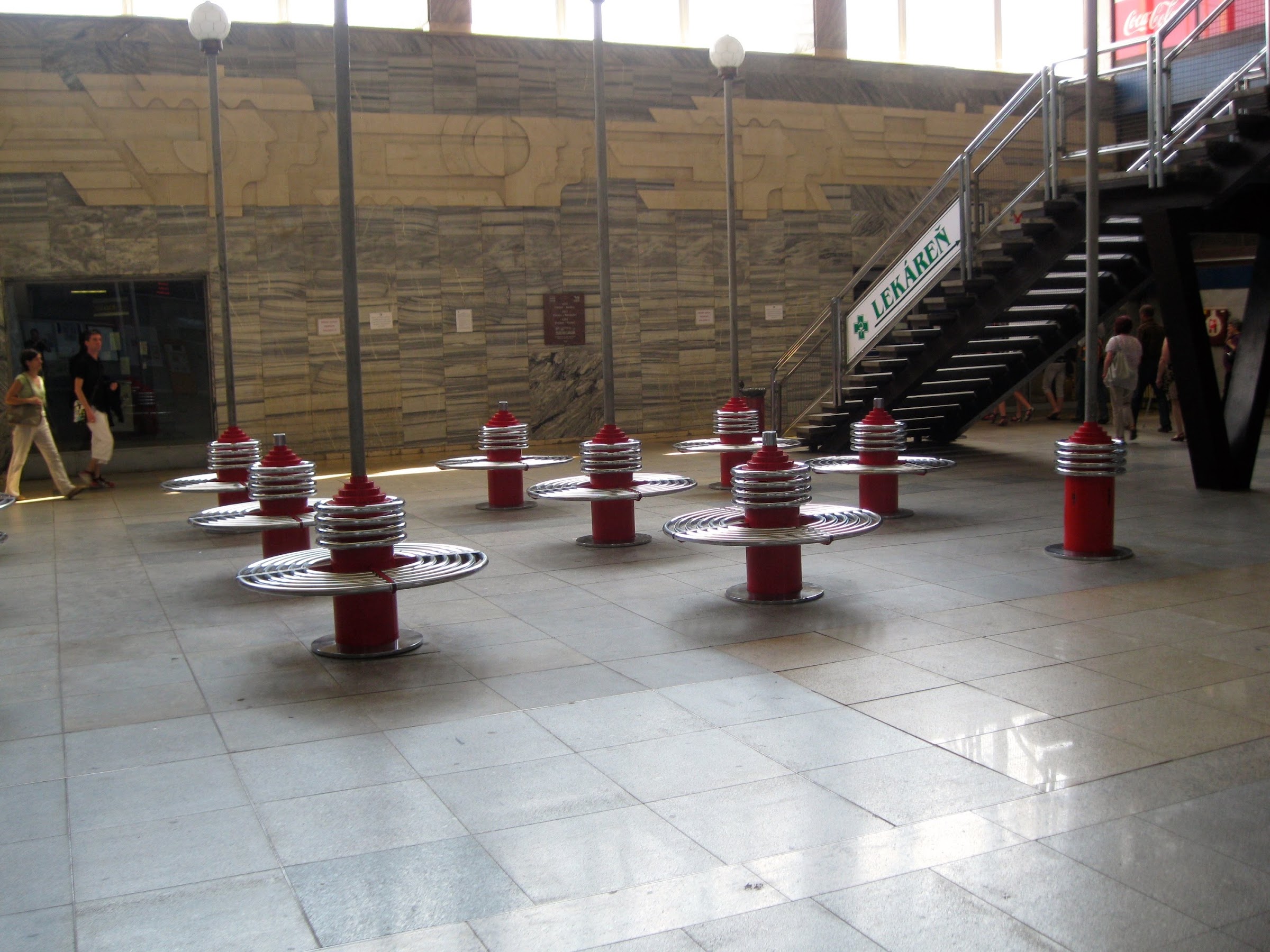 |
| The awesome, futuristic, commie-era lobby of Presov's train station. |
Just like Košice, Prešov's historical center is defined by a lengthy, lenticular shaped main square or drag, which is lined with old burgher houses that are arguably even more attractive and uniquely ornate than those on Košice's
Hlavná. Prešov's problem, however, is that, at least when we were there, it was a ghost town. There was scarcely anyone out on the streets. Some tumbleweeds blowing through the street and an Ennio Morricone spaghetti western soundtrack playing in the background are all you'd need to complete the vibe of total desertion. A stark contrast from Košice's vibrant center.
There's not a ton to do or see in Prešov. It's clearly not a major tourist destination, which isn't a bad thing of course, but then, there is a reason for that. It's really just a nice place for a lazy stroll through some rather picturesque streets.
Nevertheless, we had fun gawking at the dizzying array of cool historical facades, which run the gamut from gothic to renaissance to baroque to art nouveau.
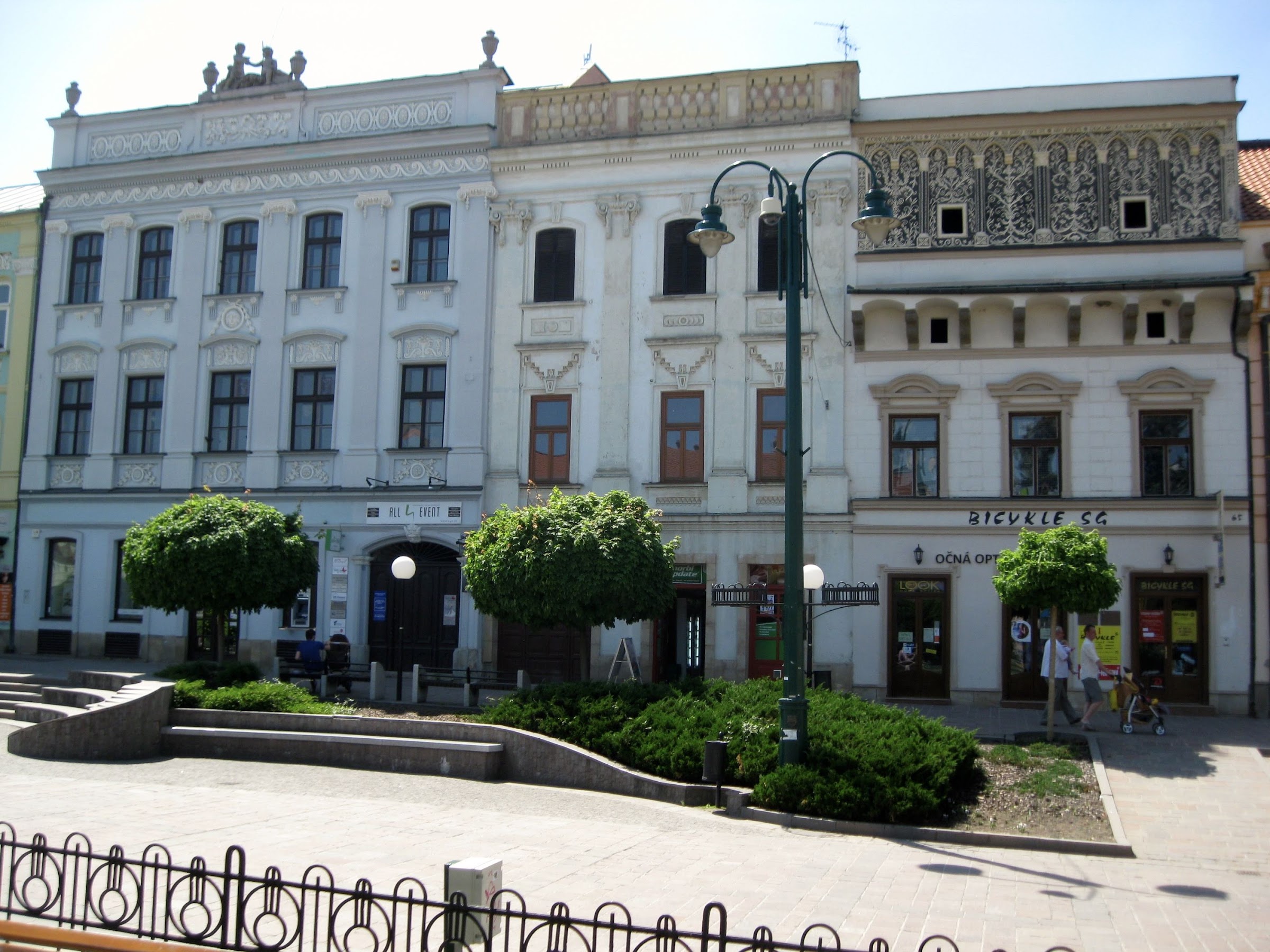 |
| Lovely facades along the main drag |
 |
| Rakoczi Palace |
We also stumbled upon an extremely communist looking park at the northern end of the main drag, which had as its centerpiece this awesome statue.
Prešov is known for a particularly violent and bloody event in the late 1600s when General Antonio Caraffa, loyal to the Habsburgs, squashed a local anti-Habsburg uprising and brutally tortured and executed 24 prominent local noblemen who were involved. He left their heads impaled on stakes located around the town's center. A few memorials to this event and its victims can be found around the town.
The medieval-era St. Nicholas cathedral at the heart of the main drag has a tall and impressive tower with a rather Prague-ish looking top. But the cathedral's whole exterior has been covered in beige plaster, so it's not very exciting to look at. I wonder if there is some nice stonework that's hiding underneath. The interior looked impressively ornate and gilded, although we could only see it through the bars of an iron gate by the entrance, as there was a wedding ceremony going on inside.
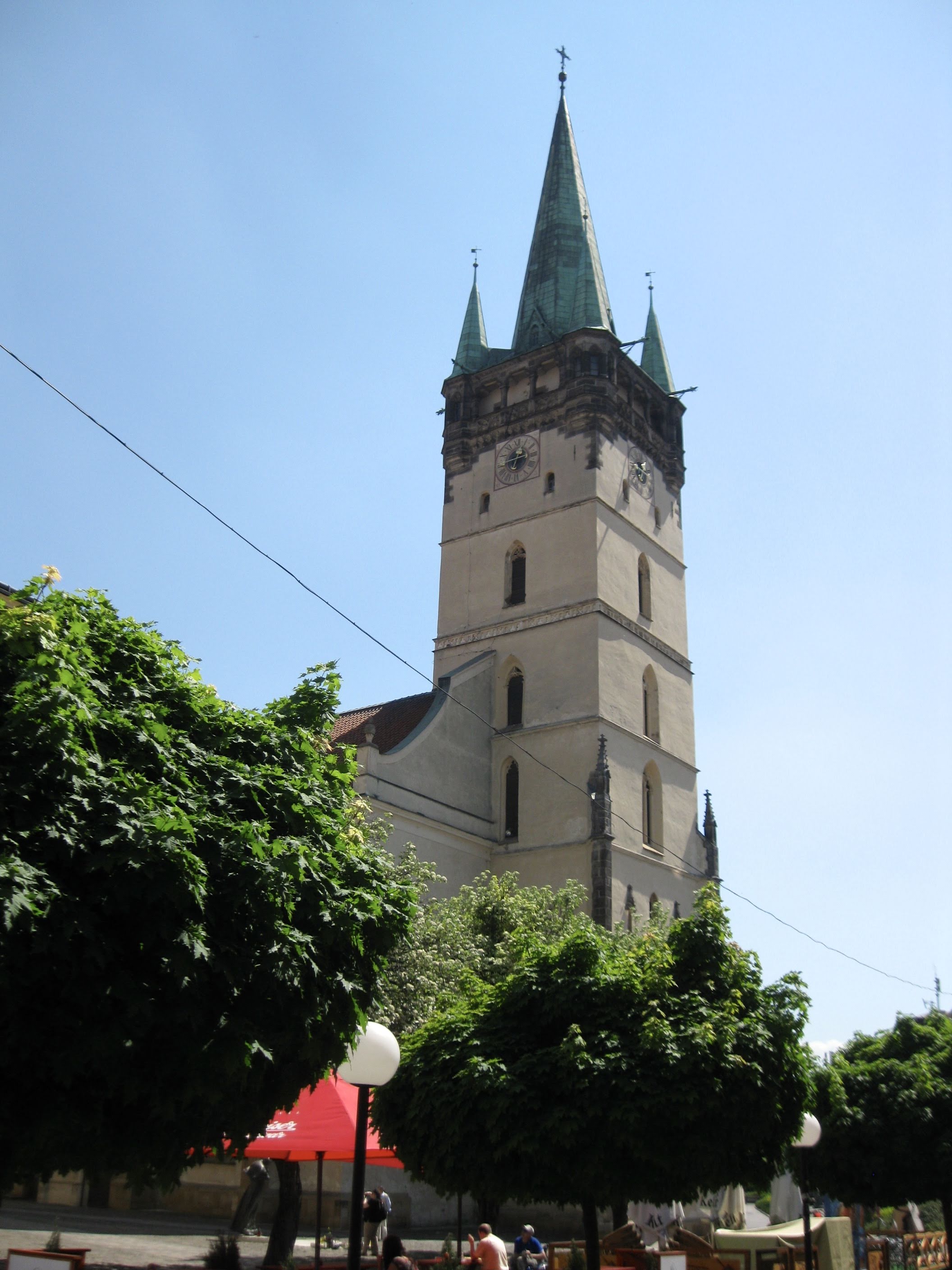 |
| St. Nicholas cathedral |
We had some greasy pizza (but with surprisingly perfect crust) and beer from the Italian-run Pizzeria Milano on an atmospheric narrow side street off the main square, after which we wandered through more narrow, historical side streets, took a gander at the old synagogue (which an American Jewish organization actually wanted to purchase and dismantle and ship to LA for reassembling; thankfully their plans were thwarted), and then headed back to the train station/bus depot, and took the bus back to Košice.
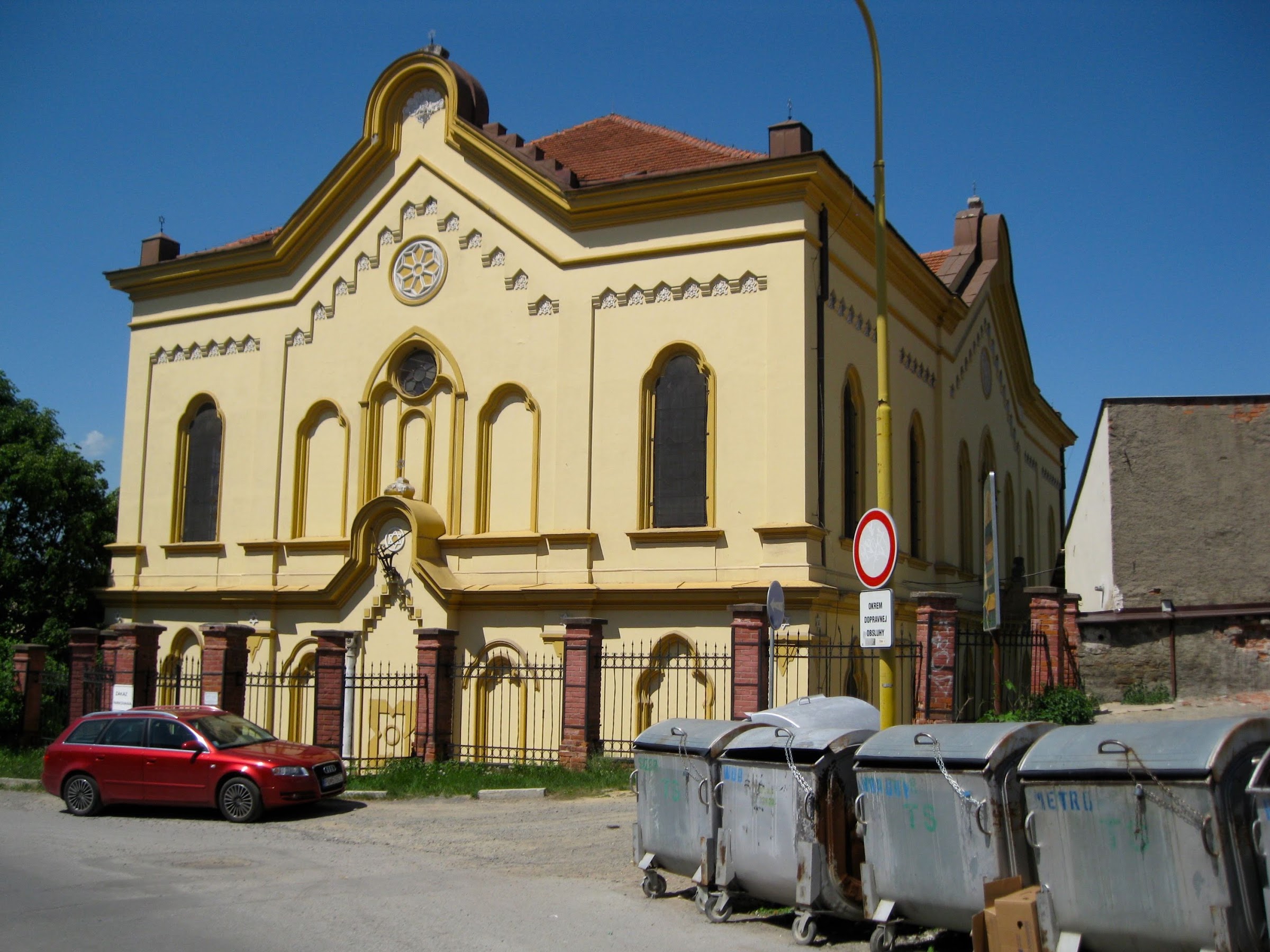 |
| Presov's old synagogue |
I'm glad we got to see Prešov, although I can't say that we're clamoring to go back. But if you're in the area, it's worth a look. If we'd have had time, it might have been interesting to venture further out from the historical center, but I have very little sense of what's out there, aside from modern shopping complexes and large networks of Soviet-era panelaks.
Back to Košice - the 2013 European Capital of Culture
Somehow Košice managed to sweet talk its way into hosting this year's European Capital of Culture (along with Marseille). The ECoC is something that two European cities host each year (several cities compete for the title), and it's become a way to boost the international stature of certain, sometimes lesser known cities, which ideally means more tourism and, of course, more revenue. In order to nab this prestigious honor, the city hatched a concept to create an environment that fosters culture and the arts with an emphasis on community involvement. The plan is to breathe new life into numerous abandoned and derelict buildings and spaces by turning them into galleries and artistic and cultural centers. The problem, however, is that despite the fact that the city has had about five years to prepare since winning the bid, most of the major projects are not finished yet, even though we're already about halfway through the year. It has been reported that some of these projects were delayed for various reasons and wouldn't be up and ready until June this year. I was curious to see what kind of progress (if any) has been made with these sites, so we ventured out to a few of them to take a look.
The biggest of these redevelopment projects, Kulturpark, is what the tourist information center's brochure describes as "the heart" of its ECoC concept, which, at the time of writing, was a sprawling, fenced off construction zone that didn't look anywhere near to being ready by June. The site contains several large old barracks which are to be transformed into art galleries, dance and artists' studios, three theater auditoriums and a cafe. Judging by what we saw, it looks like they'll be lucky if they can get this thing going by the end of the year. Mind you, this is the "heart" of the whole project!
 |
| Visualization of the Kulturpark complex |
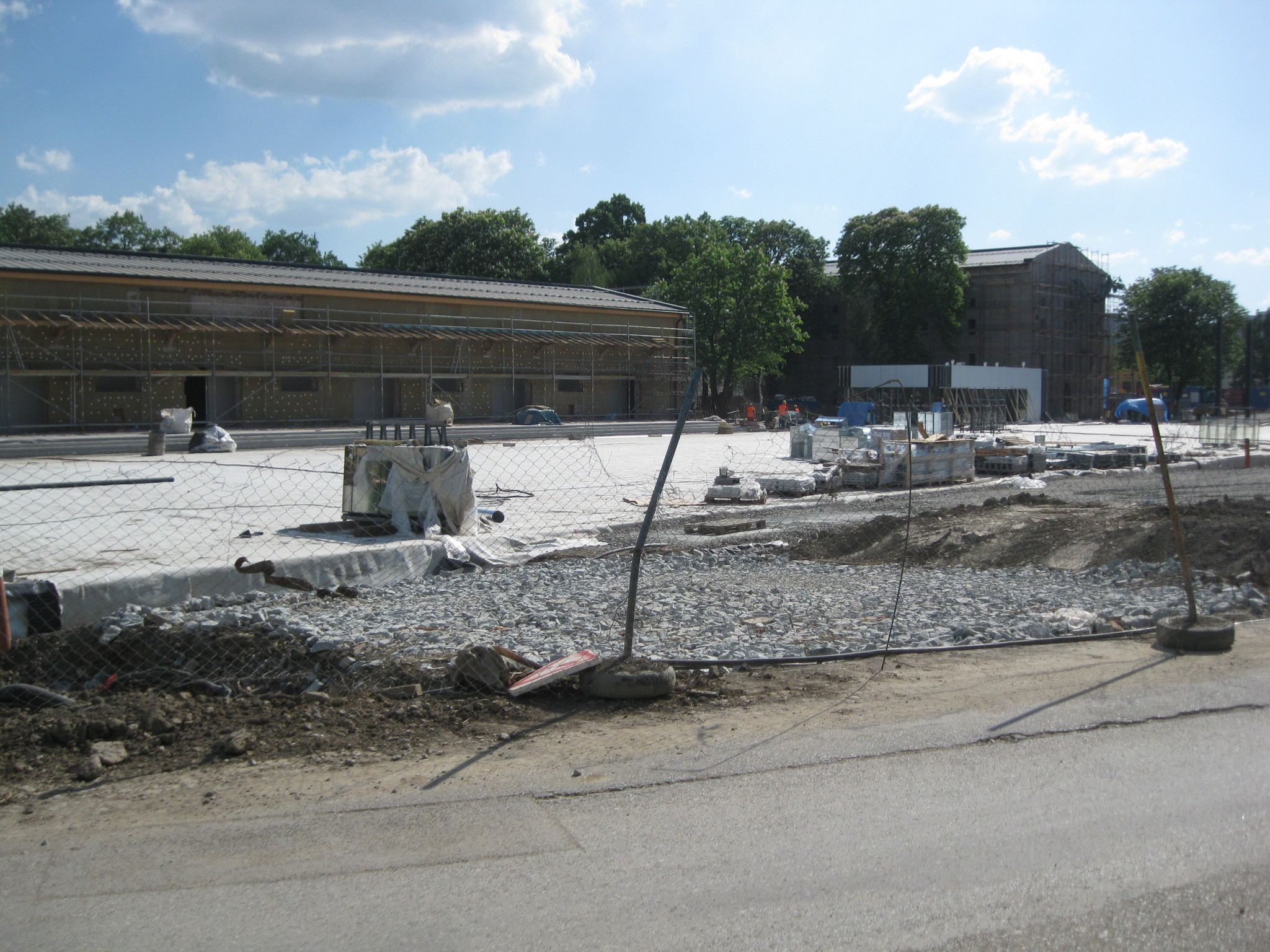 |
| The current state of Kulturpark |
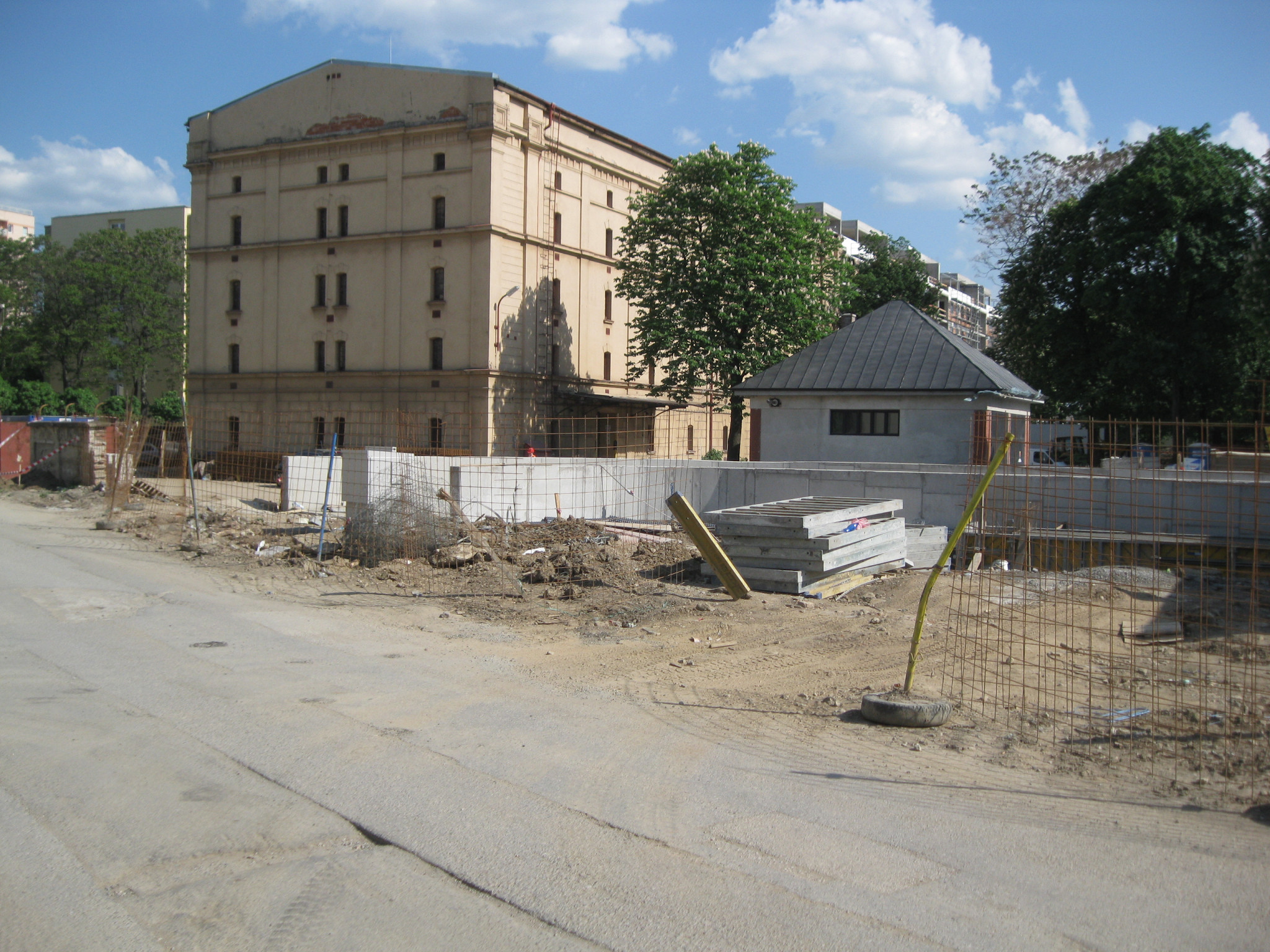 |
| More Kulturpark |
Another much talked-about project in connection with Kulturpark is the Kunsthalle, a disused indoor swimming pool in Mestsky Park that is to be transformed into an arts and cultural center. The plan is to keep the pool, and once repaired, refill it and have a stage that "floats" on the water, with theater seats placed around the pool's perimeter. While a lot of progress has been made, it still appears to be a ways off from completion.
 |
| Visualization of the Kunsthalle, once it's completed |
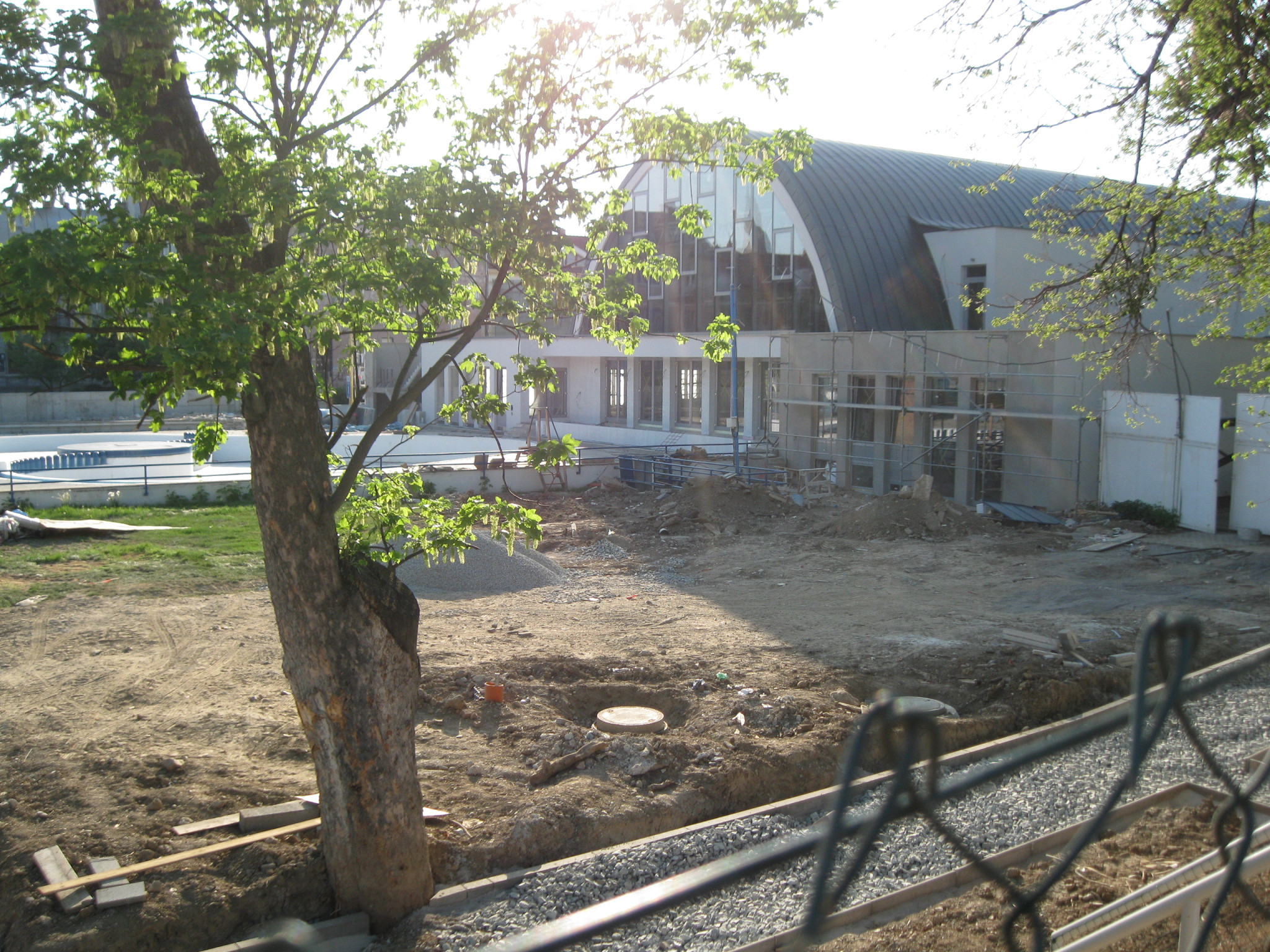 |
| Difficult to tell from this photo, but from what we could see through the windows made it appear that the Kunsthalle is a long ways off from completion. |
Yet another important element of the project are SPOTs - abandoned, former heat-exchanger stations that dot the surrounding boroughs, which have been transformed into community cultural hubs. However, none of the ECoC literature we picked up made any mention of these or told us where we could find one.
So, it seems like the city has gone to great lengths to foster a community of art and artists, and that the ECoC was a real catalyst for this. However, it's obviously quite sad that the city couldn't get its proverbial shit together to make this happen on time. City officials have been throwing around the buzzword "legacy", meaning that these projects are intended to be permanent fixtures of the city, and that it is therefore "okay" if they're not ready to go in time for ECoC. While one would hope that these structures are being repurposed for uses that can be sustained over the years, it would be nice if the city could've gotten these things going while it was in the ECoC 2013 spotlight.
Of course, the city has an ongoing schedule of other events in already established venues, like in their Philharmonic hall and various museums, so it hasn't been a total wash.
I should also note that the train station (which is a rather bleak communist-era affair) is also currently a massive construction zone. Amid all the scaffolding, torn up walls, and general construction-related commotion, are big banners that read "Welcome to the European Capital of Culture - Košice 2013". Welcome, indeed.
In summary
Ultimately, we both dug Košice, and felt it was definitely worth the trek. Would we want to live there, much less spend more than a few days there? Probably not. It's no Prague or Krakow, obviously, but it's got enough going for it to warrant a weekend excursion, and it's fairly easy on the wallet as well. We like that it's both more laid back
and livelier than Bratislava. But do we like it
more than Bratislava? Both cities have their charms and their drawbacks, so it's a tough call. It would be nice to go back and ascend the cathedral's clock tower, and hopefully, if and when we do return, the scaffolding on the cathedral's facade will have been taken down. I'd also like to venture a little further outside the center and hopefully stumble on some other idiosyncratically Slovak surprises.
Click
here to see full set of Košice photos, and
here to see all of the Prešov photos!


